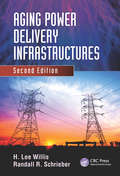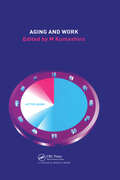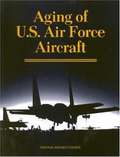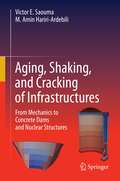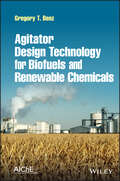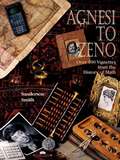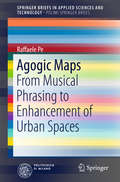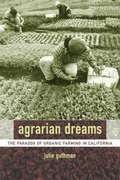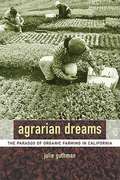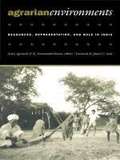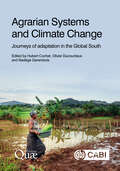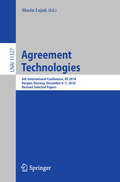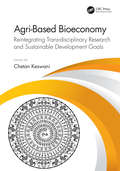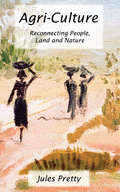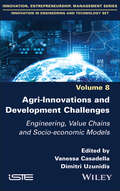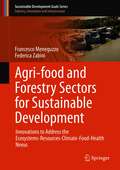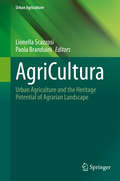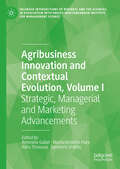- Table View
- List View
Aging Effects on Natural Fiber-Reinforced Polymer Composites: Durability and Life Prediction (Composites Science and Technology)
by Suchart Siengchin Senthilkumar Krishnasamy Chandrasekar Muthukumar Senthil Muthu Kumar ThiagamaniThis book covers the topic of degradation phenomenon of natural fiber-based composites (NFC) under various aging conditions and proposes suitable solutions to improve the response of natural fiber-reinforced composite to aging conditions such as moisture, seawater, hygrothermal, and natural and accelerated weathering. The information provided by the book plays a vital role in the durability and shelf life of the composites as well as broadening the scope of outdoor application for natural fiber-based composites. The book will be appropriate for researchers and scientist who are interested in the application of natural fiber composites in various fields.
Aging Power Delivery Infrastructures (Power Engineering (Willis) #35)
by H. Lee Willis Randall R. SchrieberGood aging infrastructure management consists of optimizing the choice of equipment and its refurbishment while also making compatible changes in all those operating and ownership policies, the whole combination aimed at optimizing the business results the power system owner desires. Both a reference and tutorial guide, this second edition of Aging Power Delivery Infrastructures provides updated coverage of aging power delivery systems, the problems they cause, and the technical and managerial approaches that power systems owners can take to manage them. See What’s New in the Second Edition: All chapters have been updated or are completely new Comprehensive discussions of all issues related to equipment aging Business impact analysis and models and engineering business studies of actual utility cases Strategy and policy issues and how to frame and customize them for specific situations This book looks at the basics of equipment aging and its system and business impacts on utilities. It covers various maintenance, service and retrofit methods available to mitigate age-related deterioration of equipment. It also presents numerous configuration and automation upgrades at the system level that can deal with higher portions of aging equipment in the system and still provide good service at a reasonable cost.
Aging and Work
by Masaharu KumashiroImprovements in health care and quality of life in recent years have led to a marked aging of the world's population, especially in well-developed regions. In the near future, this problem will spread to developing countries. The growing need to promote the health and function of aging workers presents new challenges as well as new opportunities.
Aging of U.S. Air Force Aircraft: Final Report
by Committee on Aging of U.S. Air Force AircraftMany of the aircraft that form the backbone of the U.S. Air Force operational fleet are 25 years old or older. A few of these will be replaced with new aircraft, but many are expected to remain in service an additional 25 years or more. This book provides a strategy to address the technical needs and priorities associated with the Air Force's aging airframe structures. It includes a detailed summary of the structural status of the aging force, identification of key technical issues, recommendations for near-term engineering and management actions, and prioritized near-term and long-term research recommendations.
Aging, Shaking, and Cracking of Infrastructures: From Mechanics to Concrete Dams and Nuclear Structures
by Victor E. Saouma M. Amin Hariri-ArdebiliThis self-contained book focuses on the safety assessment of existing structures subjected to multi-hazard scenarios through advanced numerical methods. Whereas the focus is on concrete dams and nuclear containment structures, the presented methodologies can also be applied to other large-scale ones.The authors explains how aging and shaking ultimately lead to cracking, and how these complexities are compounded by their random nature. Nonlinear (static and transient) finite element analysis is hence integrated with both earthquake engineering and probabilistic methods to ultimately derive capacity or fragility curves through a rigorous safety assessment.Expanding its focus beyond design aspects or the state of the practice (i.e., codes), this book is composed of seven sections:Fundamentals: theoretical coverage of solid mechnics, plasticity, fracture mechanics, creep, seismology, dynamic analysis, probability and statisticsDamage: that can affect concrete structures, such as cracking of concrete, AAR, chloride ingress, and rebar corrosion,Finite Element: formulation for both linear and nonlinear analysis including stress, heat and fracture mechanics,Engineering Models: for soil/fluid-structure interaction, uncertainty quantification, probablilistic and random finite element analysis, machine learning, performance based earthquake engineering, ground motion intensity measures, seismic hazard analysis, capacity/fragility functions and damage indeces,Applications to dams through potential failure mode analyses, risk-informed decision making, deterministic and probabilistic examples,Applications to nuclear structures through modeling issues, aging management programs, critical review of some analyses,Other applications and case studies: massive RC structures and bridges, detailed assessment of a nuclear containment structure evaluation for license renewal. This book should inspire students, professionals and most importantly regulators to rigorously apply the most up to date scientific methods in the safety assessment of large concrete structures.
Agitator Design Technology for Biofuels and Renewable Chemicals
by Gregory T. BenzAgitator Design Technology for Biofuels and Renewable Chemicals Comprehensive guide to the design, installation, selection, and maintenance of agitators in the biofuels and renewable chemicals industries Agitator Design Technology for Biofuels and Renewable Chemicals is a single-source reference on all the major issues related to agitator design for biofuel, written with the intention of saving the reader time by avoiding the need to consult multiple references or sift through many pages of text to find what is needed for agitator design in specific industries. The work presents a brief introduction of basic principles and relevant theory, then goes on to cover the real-world applications of these principles, including economic evaluations of alternatives as well as supplier evaluation principles. To aid in quick and seamless reader comprehension, each chapter has the symbols used in that chapter listed and defined at the end. Overall, the work is written more as a how-to book than an academic treatise. The highly qualified author has included plenty of brevity throughout the pages with the hopes that readers go through the entire book as a single unit, rather than just skimming an occasional page or chapter as is common with other resources in similar fields. Sample topics covered in the work include: Avoiding common problems, such as using impeller diameters and speeds that would not result in even minimal solids suspension or liquid motion Choosing the right impellers for the job, understanding how power draw and pumping are calculated, and becoming familiar with biofuel/biomass agitator sizing guidelines The principles and limitations of scale-up and the most common non-Newtonian rheology applicable to biofuel applications Designing lab tests and scale-up cellulosic hydrolysis agitation, plus the uses and limitations of Computational Fluid Dynamics (CFD) As an easy-to-read and completely comprehensive resource to the subject, Agitator Design Technology for Biofuels and Renewable Chemicals is immensely valuable for professionals tasked with selecting agitation equipment or troubleshooting existing equipment, as well as those involved in planning activities and allocating resources related to project management.
Agitator Design for Gas-Liquid Fermenters and Bioreactors
by Gregory T. BenzThis book is concise reference to designing mechanically sound agitation systems that will perform the process function efficiently and economically. Currently, all the books on bioreactor and fermenter design do not focus specifically on agitation. Sections cover agitator fundamentals, impeller systems, optimum power and air flow at peak mass transfer calculations, optimizing operation for minimum energy per batch, heat transfer surfaces and calculations, shaft seal considerations, mounting method, mechanical design, and vendor evaluation.
Agnesi to Zeno: Over 100 Vignettes From the History of Math
by Sanderson SmithAgnesi to Zeno: Over 100 Vignettes from the History of Math presents a series of vignettes that highlight developments in mathematical thought and achievement as they relate to human history. For the most part, the vignettes are chronologically arranged; topics that span long periods of time are placed strategically throughout the book.
Agogic Maps: From Musical Phrasing to Enhancement of Urban Spaces (SpringerBriefs in Applied Sciences and Technology)
by Raffaele PeThis book explores the value of the musical concept of "agogics" - the modification of regular rhythm to enhance expressive potential - in understanding urban spatial configurations within the current technological context and in developing urban maps that exploit sonic signals to create an open learning framework. The book starts by discussing the meaning and significance of agogics in the musical and artistic realm, with reference to the work of Adolphe Appia, Emile-Jaques Dalcroze, and Iannis Xenakis, among others. Its relevance to cartography and mapping is then examined, taking into account the contributions of Ian McHarg, Bill Hillier, Mark Shepard, and Robin Minard. The nature and value of agogic maps, for example in fostering awareness of place and effective organization of spatial development, are described in detail, with reference to case studies in Dar es Salaam, Tanzania and Segrate, Italy. It is explained how agogic maps take advantage of innovative categories and scripting equipment to provide a new mapping instrument for spatial and urban configurations, highlighting the interdependence between aural signals and spatial variables. This book will be of interest to architects, urbanists, and musicians with a specific interest in space and sound design.
Agrarian Dreams
by Julie GuthmanIn this groundbreaking study of organic farming, Julie Guthman challenges accepted wisdom about organic food and agriculture in the Golden State. Many continue to believe that small-scale organic farming is the answer to our environmental and health problems, but Guthman refutes popular portrayals that pit "small organic" against "big organic" and offers an alternative analysis that underscores the limits of an organic label as a pathway to transforming agriculture. This second edition includes a thorough investigation of the federal organic program, a discussion of how the certification arena has continued to grow and change since its implementation, and an up-to-date guide to the structure of the organic farming sector. Agrarian Dreams delivers an indispensable examination of organic farming in California and will appeal to readers in a variety of areas, including food studies, agriculture, environmental studies, anthropology, sociology, geography, and history.
Agrarian Dreams: The Paradox of Organic Farming in California
by Julie GuthmanIn this comprehensive study of organic farming in California, Julie Guthman casts doubt on the current wisdom about organic food and agriculture, at least as it has evolved in the Golden State. Refuting popular portrayals of organic agriculture as a small-scale family farm endeavor in opposition to "industrial" agriculture, Guthman explains how organic farming has replicated what it set out to oppose.
Agrarian Dreams: The Paradox of Organic Farming in California
by Julie GuthmanIn an era of escalating food politics, many believe organic farming to be the agrarian answer. In this first comprehensive study of organic farming in California, Julie Guthman casts doubt on the current wisdom about organic food and agriculture, at least as it has evolved in the Golden State. Refuting popular portrayals of organic agriculture as a small-scale family farm endeavor in opposition to "industrial" agriculture, Guthman explains how organic farming has replicated what it set out to oppose.
Agrarian Environments: Resources, Representations, and Rule in India
by David Gilmartin K. Sivaramakrishnan Margaret Mckean Arun Agrawal Peter VandergeestAgrarian Environments questions the dichotomies that have structured earlier analyses of environmental processes in India and offers a new way of looking at the relationship between agrarian transformation and environmental change. The contributors claim that attempts to explain environmental conflicts in terms of the local versus the global, indigenous versus outsiders, women versus men, or the community versus the market or state obscure vital dynamics of mobilization and organization that critically influence thought and policy. Editors Arun Agrawal and K. Sivaramakrishnan claim that rural social change in India cannot be understood without exploring how environmental changes articulate major aspects of agrarian transformations--technological, cultural, and political--in the last two centuries. In order to examine these issues, they have reached beyond the confines of single disciplinary allegiances or methodological loyalties to bring together anthropologists, historians, political scientists, geographers, and environmental scientists who are significantly informed by interdisciplinary research. Drawing on extensive field and archival research, the contributors demonstrate the powerful political implications of blurring the boundaries between dichotomous cultural representations, combine conceptual analyses with specific case studies, and look at why competing powers chose to emphasize particular representations of land use or social relations. By providing a more textured analysis of how categories emerge and change, this work offers the possibility of creating crucial alliances across populations that have historically been assumed to lack mutual goals. Agrarian Environments will be valuable to those in political science, Asian studies, and environmental studies.Contributors. Arun Agrawal, Mark Baker, Molly Chattopadhyaya, Vinay Gidwani, Sumit Guha, Shubhra Gururani, Cecile Jackson, David Ludden, Haripriya Rangan, Paul Robbins, Vasant Saberwal, James C. Scott, K. Sivaramakrishnan, Ajay Skaria, Jennifer Springer, Darren Zook
Agrarian Systems and Climate Change: Journeys of adaptation in the Global South
by Hubert Cochet Olivier Ducourtieux Nadège GaramboisThis book examines the link between global change and impacts and adaptation at the local level, combining a systemic approach and connecting different scales of analysis. It unravels the complex ties between the scenarios developed at global, continental, regional scales of analysis and farmers' concrete experiences, lived at the territorial level. In addition to this great discrepancy in terms of scales of analysis and understanding of processes, there is a need to relate the multi-generational scale of possible climatic changes to that of agricultural practices carried out on the agricultural season level. Based on the detailed study and comparison of a dozen contrasting local situations in sub-Saharan Africa and South-East Asia, the authors highlight the processes and trajectories which explain the high exposure to the hazards of different groups of farmers, as well as their unequal capacity to adapt. They explain the causes of this vulnerability and illustrate the weight of past and current choices in terms of agricultural, environmental and trade policies. Finally, they present the adjustment modalities and the past and current transformations of peasant practices moving towards a reduction in exposure to hazards, a reduction in vulnerability, and better adaptation to global changes: climate change, demographic growth, increased competition for access to resources, changes in relative prices and market fluctuations, deregulation and decline in public support, etc. In conclusion, they outline possible paths in terms of adaptation and proposals for political measures to support producers.
Agreement Technologies: 6th International Conference, At 2018, Bergen, Norway, December 6-7, 2018, Revised Selected Papers (Lecture Notes in Computer Science #11327)
by Marin LujakThis book constitutes the revised selected papers from the 6th International Conference on Agreement Technologies, AT 2018, held in Bergen, Norway, in December 2018. The 11 full papers and 6 short papers presented in this volume were carefully reviewed and selected from a total of 28 submissions. The papers discuss new ideas and techniques for the design, implementation and verification of next generation open distributed systems centered on the notion of agreement among computational agents. They are organized in the following topical sections: AT foundations and modelling of reasoning agents; argumentation and negotiation; coordination in open distributed systems with applications.
Agri-Based Bioeconomy: Reintegrating Trans-disciplinary Research and Sustainable Development Goals
by Chetan KeswaniThis volume concentrates on the recent scientific advancements in agricultural biotechnology and reintegrates it with socio-economic, industrial and intellectual property aspects of agricultural biotechnology and its implications for accomplishing the sustainable development goals. Adopting a unique approach, this book amalgamates science and business perspectives from an insider’s viewpoint on the agro-biotech industry, laying the foundations for students and professionals alike. This book: Is a first of its kind by addressing the recent issues emerging in agro-based economies. Will be a single-point source for recent advancements in agro-based global bioeconomy. Empowers the utilization of biotechnology to address worldwide ecological issues by supporting sustainable resolutions for global agricultural markets. Gives both foundational hypothesis and functional direction on commercialization and regulatory issues. Empowers the usage of adaptable approaches that can adjust to and uphold socially and financially valuable agro-based technologies.
Agri-Culture: "Reconnecting People, Land and Nature"
by Jules Pretty'Refreshingly fluent narrative, brimming full of stories and metaphors' Tim O'Riordan, University of East Anglia, UK 'A great balance between storytelling and analysis which points to the critical need for gaining control over resources' Jacqueline Ashby, CIAT, Colombia 'Full of supporting evidence and clear arguments' Norman Uphoff, Cornell University, US 'A wonderful book, put together with such vision and passion' Mark Ritchie, Institute of Agriculture and Trade Policy, US 'A superb volume. This is a valuable monograph that all policy-makers, scholars and farmers must read to understand their roles and responsibilities' Vo-Tong Xuan, Angiang University, Vietnam 'Beautifully written. The implications of the book's ideas are deep and extensive' Julia Guivant, University of Florianopolis, Brazil Something is wrong with our agricultural and food systems. Despite great progress in increasing productivity in recent decades, hundreds of millions of people remain hungry and malnourished, and further millions suffer for eating too much food or the wrong sort. Agri-Culture envisages the expansion of a new form of food production and consumption founded on more ecological principles and in harmony with the cultures, knowledges and collective capacities of the producers themselves. It draws on many stories of successful agricultural transformation in developing and industrialized countries, but with a warning that true prosperity will depend on the radical reform of the institutions and policies that control global food futures, and fundamental changes in the way we think. The time has come for the next agricultural revolution.
Agri-Innovations and Development Challenges: Engineering, Value Chains and Socio-economic Models
by Dimitri Uzunidis Vanessa CasadellaInnovation is a major challenge for economic development and social progress. Faced with the ecological and food problems that the world is currently experiencing, the legitimacy of innovation takes on its full meaning, particularly in developing countries. As emphasized by international organizations (UN, FAO), building skills and abilities in the agricultural and food sectors are necessary when launching innovation processes for the benefit of suffering populations. This book deals with different experiences launched in many developing countries in these sectors and shows how local initiatives can provide answers to the pessimism of experts and the media. Multidisciplinary analysis and practices explain how collective work creates value chains that can foster local and national economic development. The authors revisit the innovation agri-food models that contribute to economic development. Agri-Innovations and Development Challenges is composed of general presentations of innovations applied in developing countries, as well as specific studies on the joint valorization of knowledge and experience in agri-food engineering
Agri-Tech Approaches for Nutrients and Irrigation Water Management
by Shivam Gupta, Sushil Kumar Himanshu and Pankaj Kumar GuptaThis book includes concepts, methodologies, and techniques used in soil nutrients and irrigation water management with regional and global prospects. This book accommodates up-to-date approaches to agricultural technologies along with future directions and compiles a wide range of articles ranging from soil moisture flow, nutrient dynamics, crop water estimation techniques, approaches to improve crop water productivity and soil health, crop simulation modeling, and remote sensing/GIS applications. The book also includes chapters on climate-resilient agriculture, advances in big data and machine-learning techniques, IoT, plasma technology, seed priming, and precision farming techniques and their environmental/economic impacts.Features:• Discusses applications sustainable technologies for soil nutrients and irrigation water management at multi-scale. • Covers application of remote sensing/GIS, big data and machine learning, IoT, plasma technology, seed priming, and precision farming techniques for nutrients and water management.• Reviews concepts, methodologies, and techniques being used in soil nutrients and irrigation water management. • Provides up-to-date information as well as future directions in the field of nutrients and agricultural water management.This book is aimed at researchers and graduate students in agriculture, water resources, environment, and irrigation engineering.
Agri-food and Forestry Sectors for Sustainable Development: Innovations to Address the Ecosystems-Resources-Climate-Food-Health Nexus (Sustainable Development Goals Series)
by Francesco Meneguzzo Federica ZabiniThis book surveys state-of-the-art and prospective practices, methods and technologies in agri-food and forestry sectors to document the potential measurable improvements in areas of environmental management, food security, economic growth, social cohesion and human health at the local and global scale. With a focus on the ecosystems-resources-climate-food-health nexus as a framework towards achieving the UN Sustainable Development Goals applicable in these sectors, the book offers a portfolio of guidelines and standards that assesses the affordability, potential profitability and possible unintended consequences of interventions. The areas of intervention covered in the study include global and local forest resources management, safe wastewater reuse for irrigation, sustainable crop and plant protection (e.g. biopesticides, bioherbicides), carbon sequestration and emission reduction strategies, and safe processing methods for food and food waste (e.g. sustainable food preservatives and healthier food). The book is primarily intended for academics, professionals, and policymakers. The professional audience, including enterprises in the forestry, farming, food processing, healthcare and waste management sectors, will take advantage of the updated knowledge basis concerning the innovations in the respective practices, methods and technologies, including their feasibility, affordability and profitability, and policymakers will find useful the comprehensive review of these innovations which could be strategically promoted and deployed in the next decade, with the aim of achieving the UN Sustainable Development Goals.
AgriCultura: Urban Agriculture and the Heritage Potential of Agrarian Landscape (Urban Agriculture)
by Lionella Scazzosi Paola BranduiniThis book explains how cultural heritage can be a tool for enhancing urban agriculture and improving landscape and life quality. It cuts across the existing literature and fills the gaps between urban agriculture, considered as a food, social and environmental opportunity and cultural heritage, considered as resource. It focuses the role of the countryside for urban areas, in the history of the city and today. Its attention is on the quality for all areas, both outstanding, ordinary and degraded, as well as large, little or fragmented (European landscape convention 2000). It considers agricultural landscape as a system of tangible and intangible heritage components and relationships, to be retained, enhanced and transmit, in a process of inevitable but appropriate dynamic conservation and management over time (ICOMOS-IFLA Principles 2017). This book can benefit the collaboration among local players – such as farmers, citizens, associations, public institutions, stakeholders – in conserving and enhancing agrarian heritage and reinforcing the identity of places and people. It can strengthen collective action and generate positive effects on good large and local -scale management. The first part has a methodological character in order to enlighten the integrated approach between cultural heritage and urban agriculture. The second part exemplifies cases where the heritage has been recognised but not yet translated into concrete action. The third Part discloses ongoing process of co-construction, where policies have recognized the cultural, environmental and social meaning of urban agriculture as heritage. This book aims to reach scholars, local administrations, professionals, farmers and citizens. It involves many authors, many of whom are directly engaged with action-research in safeguarding and implementing the mutual interaction between urban agriculture activities and agrarian heritage.
AgriScience (5th edition)
by Jasper S. Lee Diana L. TurnerAgriScience, Fifth Edition, represents new student- and teacher-friendly approaches that blend science with the fundamentals of agriculture. Since agriculture is applied science, this is a highly useful and practical approach. Principles of science are presented and reinforced using agricultural applications. Of course, a broad interpretation of agriculture is used that includes crop and animal production as well as horticulture, forestry, marketing, and processing. The contents of AgriScience relate science information to useful applications in plant and animal production. Some things that sound complicated in the science classroom are used every day in the agriculture classroom. Practical applications result in academic connections that reinforce studies in related academic classes. This edition has updated and expanded content in a number of areas. The contents of the book have been reshaped to incorporate the Agriculture, Food and Natural Resources (AFNR) Career Cluster and the eight career pathways that are included.
AgriScience Explorations
by Jasper S. Lee Elizabeth M. Morgan Elizabeth WilsonNIMAC-sourced textbook
Agribusiness Innovation and Contextual Evolution, Volume I: Strategic, Managerial and Marketing Advancements (Palgrave Intersections of Business and the Sciences, in association with Gnosis Mediterranean Institute for Management Science)
by Demetris Vrontis Alkis Thrassou Antonino Galati Mariantonietta FioreAgriculture is the oldest and most traditional of economic sectors, and its business has seen major evolutionary leaps over the past century. Contemporary agribusiness is being influenced and reshaped by technological advancements, geopolitical developments, globalisation, transport and logistics innovations, as well as changes in industry structure and consumer behaviour. Reflecting on these changes and providing a deep dive into this sector, this two-volume scientific works’ collection defines, refines, analyses, and prescribes the evolution of agribusiness in the present and future. Taken together, the books offer a comprehensive conceptualisation of the multifactorial macro, micro and organisational elements of agribusiness, including strategic, managerial, marketing, technological and geo-socio-political forces. Volume I explores the strategic, managerial and marketing aspects of contemporary agribusiness, and descriptively and prescriptively investigates the organisational and immediate industry practices and sectoral forces. Topics covered include circular business models, CSR communication practices, digital marketing, organisational sustainability and contemporary farming systems, to name a few..
Agribusiness Innovation and Contextual Evolution, Volume II: Technological, Societal and Channel Advancements (Palgrave Intersections of Business and the Sciences, in association with Gnosis Mediterranean Institute for Management Science)
by Demetris Vrontis Alkis Thrassou Antonino Galati Mariantonietta FioreAgriculture is the oldest and most traditional of economic sectors, and its business has seen major leaps in innovation over the past century. Contemporary agribusiness is being influenced and reshaped by technological developments, geopolitical developments, and globalisation, as well as transport and logistics innovations, changes in consumer behaviour.Reflecting on these changes and providing a deep dive into this sector, this two-volume work defines, refines, analyses, and prescribes the evolution of agribusiness in the present and future. Taken together, the books offer a comprehensive conceptualisation of the multifactorial macro, micro and organisational elements of agribusiness, including strategic, managerial, marketing, technological and geo-socio-political forces.Volume II focuses on the wider, macro-environmental forces acting upon agribusinesses, exploring the contextual evolutions that impact the sector, and the means, practices and avenues for its development.It includes topics such as digital technologies adoption, supply chain sustainability, big data analytics, women’s agricultural entrepreneurship, and simulation model decision making.

